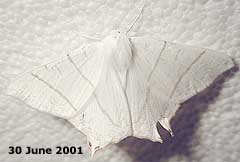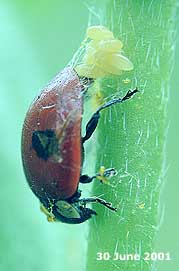Go to the last entry..................................Go to previous entry
17 June - Just a short entry today to announce the opening of the first flower on a Nipplewort plant (Lapsana communis) that I have allowed to grow next to the small pond. There are quite a few flower buds in branched clusters. The flower is about 16mm across. I saw only the second ladybird this year in the garden today even though here is plenty of ladybird food (aphids) on the stinging nettles and other plants. Back on the 5th I took a photograph of a burrow made by a solitary bee. I should have said that within a day I found the entrance sealed. There seems to have been a pause in the activities of the solitary bees this last week. I have not seen any activity around the bee hotels. While the bumble bees continue to visit the flowers in the garden, I have not seen smaller bees about. There has been a large wasp visiting our potted 'Christmas tree' over the last few days although I have taken no pictures yet. The blue tit family has had a couple of mass feeding sessions and a couple of times there were three adults in the feeder box at the same time. At one time a fledgling entered it and took a while to find its way back out.
This Hover fly was having breakfast on the Bamboo leaves. The meal was the sticky deposits provided by the aphids. My Collins guides suggest that it is very similar to Syrphus ribesii.
This spider was spotted this morning on a dead Ivy leaf among the Stinging Nettles. It was busy spinning a silk framework over its egg case which measured about 3mm across. A look in my Larousse Guide to Spiders did not come up with a similar spider - some more searching needed for this one. While the female blackbird continues to sit on her nest, the Blue Tit parents seem to be far less ready to feed their offspring now. There has been a lot less activity at the feeder even though the juveniles are still calling for food and flying to the area around the feeder.
Tonight a quick check down the garden with headlamp on revealed this pair of mating ladybirds on the bamboo plant, with an aphid taking a close interest in the proceedings.
On the next leaf was this young cricket which is different to the ones I have already been watching. This one is about 7mm long and has shorter antennae in relation to its body. I shall have to watch out for it in daylight.
This spider was 'captured by torchlight tonight, among the sticky spots of aphid deposits. The spider's body is about 8mm long. A look in my Larousse guide gives Clubiona pallidula as a possible indentification for it.
There was no sign of the cricket on the bamboo today.
Incidently, the flowering heads of the grass are towering some 6 feet about the surface of the pond. If I have a chance tomorrow I shall come up with an identification.
Tonight I disturbed a fox in the garden. Unfortunately I was not able to get a good look at it as it escaped over the fence. A short time later I saw it crossing our road, followed closely by a cat!
This ground beetle was spotted yesterday as it moved about in the undergrowth. My books suggest that it is a Pterostichus madidus.
Here are a couple of ladybird variants spotted on the bamboo in the last couple of days. The first one, with the red spots, is a black version of a Two-spot Ladybird. The second one is not matched in my insect book, but my guess is that it is a variant of a Ten-spot Ladybird. Notice the little flashes of red at the front of the large spots and at the sides.
Yesterday I spotted this fly that seemed to be laying eggs in (or on) flower buds on what I think is a ragwort (more about that when its flowers open). The fly was about 4-5mm long. I have not identified it yet.
Over the last few days I have seen a few damsel flies, but have yet to get close enough to photograph one. The blackbirds have become a lot more relaxed(?) now with squabbles happening only rarely. The pair seem to be together most of the time. I am not sure if the female has in fact abandoned her recent attempt at nesting. The male robin only appears occasionally - I saw a juvenile down feeding under the Hawthorn on Monday. The Blue tit family seems to have broken up. While the juveniles are about, I no longer hear the 'feed me' calls and they are largely ignored by the adults. The younsters will take mealworms for themselves now, although they seem uncertain as to how they should deal with them. 29 June - No pictures today, but a few comments about bird activity. A song thrush made a brief appearance for the first time since March. A juvenile Robin was down feeding under the Hawthorn again. There are definite flashes of red on its breast now. I shall have to try a get a picture of it. The Blackbird pair are down on the ground feeding frequently but the female has definitely abandoned her nest and shows no sign of building another. The seed feeder was very busy today, with lots of sparrows in the hawthorn and frequent visits by Greenfiches and a female chaffinch. There was an almost constant Starling presence in the garden today, with the juveniles looking very plain compared with the adults.
Back in the house I found this Swallow-tailed Moth (Ourapteryx sambucaria). It is also a large moth, measuring just under 6cm.
Today it is quite windy so not a good day for quick pictures of the small beasts in the garden. However, I spotted this Two-spot Ladybird laying eggs, head-down on the stem of a Water Forget-me-not. Has she walked through a web before starting to lay or has she produced the threads as part of the process? |
|
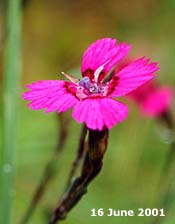 16
June - A largely wet day meant that very little time was
spent in the garden. However, a bit of brightness came in the
form of the first flowers open on the Maiden Pink plant (Dianthus
deltoides).
16
June - A largely wet day meant that very little time was
spent in the garden. However, a bit of brightness came in the
form of the first flowers open on the Maiden Pink plant (Dianthus
deltoides).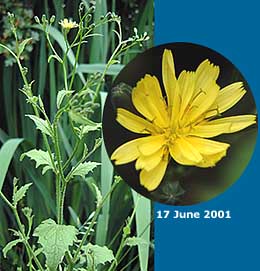
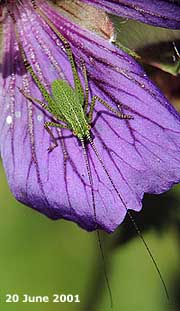 20
June - In the last
week of May I put the first picture of a Bush cricket (body 2mm
long). Nearly a month later and the group of Crickets are still
thriving on the White dead Nettle and Geranium plants, I could
see nine of them today. This one was enjoying the early morning
sunshine. While its body is about 6-7mm long, its antennae are
three times as long.
20
June - In the last
week of May I put the first picture of a Bush cricket (body 2mm
long). Nearly a month later and the group of Crickets are still
thriving on the White dead Nettle and Geranium plants, I could
see nine of them today. This one was enjoying the early morning
sunshine. While its body is about 6-7mm long, its antennae are
three times as long.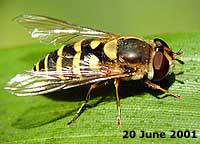
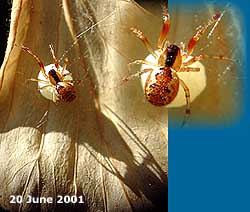 The spiders in the garden have been
making themselves scarce over recent weeks, perhaps becoming
food for young birds. I certainly saw the Blue tit parents hunting
and taking spiders to their chicks.
The spiders in the garden have been
making themselves scarce over recent weeks, perhaps becoming
food for young birds. I certainly saw the Blue tit parents hunting
and taking spiders to their chicks.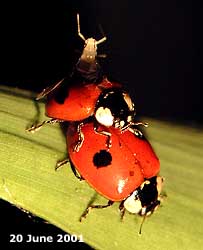
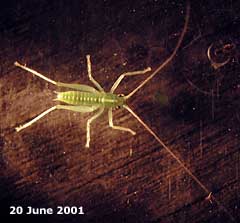
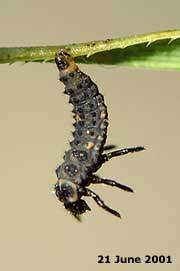 21
June - Two more images
from the bamboo plant. The first taken this morning of a ladybird
nymph. I am curious as to why it was hanging in this way - it
was very much alive when I took the photograph.
21
June - Two more images
from the bamboo plant. The first taken this morning of a ladybird
nymph. I am curious as to why it was hanging in this way - it
was very much alive when I took the photograph.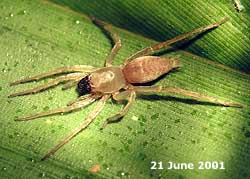
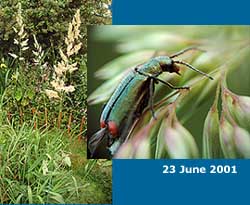 23
June - Just a short
entry to record the appearance of a beetle on one of the grasses
growing in the pond. My Collins guide identifies it as a female
Malachius bipustulatus. About 9mm long, it is quite a
hairy beetle that hunts for other insects among flowers and grasses.
23
June - Just a short
entry to record the appearance of a beetle on one of the grasses
growing in the pond. My Collins guide identifies it as a female
Malachius bipustulatus. About 9mm long, it is quite a
hairy beetle that hunts for other insects among flowers and grasses.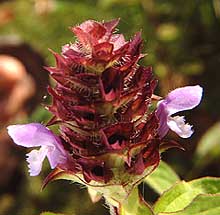 27
June - A bit of catching
up needs to be done today. I'll start with the Selfheal (Prunella
vulgaris), which started flowering on the 24th. There are
two clumps of this by the side of the big pond.
27
June - A bit of catching
up needs to be done today. I'll start with the Selfheal (Prunella
vulgaris), which started flowering on the 24th. There are
two clumps of this by the side of the big pond.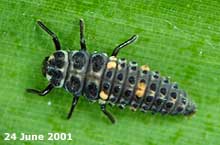 .......
.......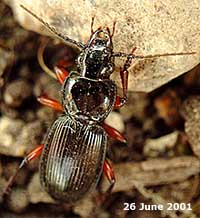
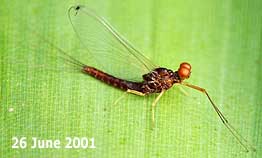
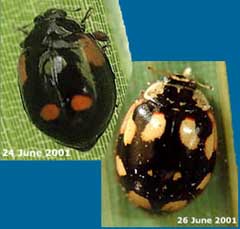
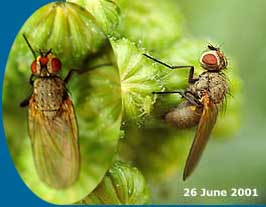
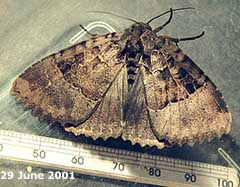 30
June - First of all,
an update on yesterday's entry. After shutting down the computer
I had my usual wander down the garden. The last few nights have
seen an upsurge in moth activity and I came across this large
specimen on the Burberris bush. The nearest match in my butterfly
guide is an Old Lady (Mormo maura). It measures 6cm across
at rest and must be 8cm at least in flight.
30
June - First of all,
an update on yesterday's entry. After shutting down the computer
I had my usual wander down the garden. The last few nights have
seen an upsurge in moth activity and I came across this large
specimen on the Burberris bush. The nearest match in my butterfly
guide is an Old Lady (Mormo maura). It measures 6cm across
at rest and must be 8cm at least in flight.